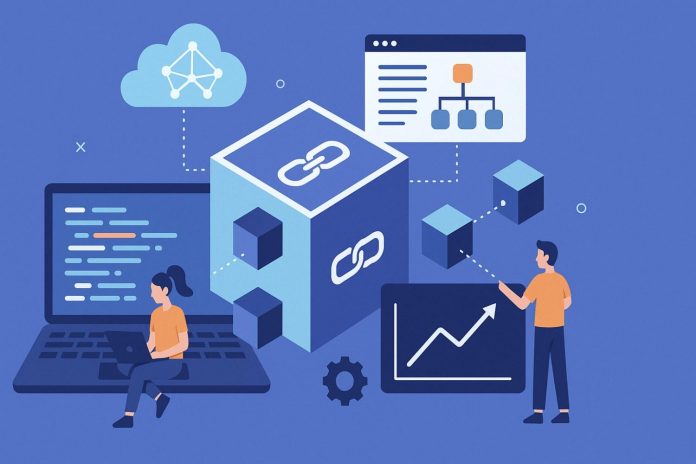Introduction
The term Blockchain has transcended its origins in cryptocurrency to become a buzzword synonymous with digital trust, transparency, and decentralization. But what exactly is blockchain development? It’s more than just coding; it’s the specialized craft of building the secure, distributed systems that will power the next generation of the internet, often referred to as Web3.
At its core, blockchain development is the process of designing, building, and maintaining applications and systems that utilize the foundational principles of blockchain technology. This includes everything from crafting the underlying network architecture to developing the user-facing decentralized applications (DApps) that run on top of it. It’s a field that demands a unique blend of expertise in computer science, cryptography, and network engineering.
According to Grand View Research The global blockchain technology market size was estimated at USD 31.28 billion in 2024 and is projected to reach USD 1,431.54 billion by 2030, growing at a CAGR of 90.1% from 2025 to 2030.
The Architecture of Trust: Core Concepts
To grasp blockchain development, one must first understand the fundamental concepts that make the technology so disruptive. Developers work directly with these components to create secure and efficient systems:
Decentralization
Unlike traditional centralized databases controlled by a single entity (like a bank or a company), blockchain is a distributed ledger. This means data is spread across a vast network of computers, or nodes. No single party has unilateral control, which significantly increases security and resilience against censorship or single points of failure. Blockchain developers ensure that the network’s data structure and communication protocols uphold this decentralized philosophy.
Immutability
This is perhaps the blockchain’s most defining feature. Once a transaction is recorded in a block and that block is added to the chain, it cannot be altered or deleted. Each block contains a cryptographic hash of the previous block, creating a chronological, tamper-proof chain. Any attempt to change a past record would invalidate the hashes of all subsequent blocks, immediately alerting the network. This unchangeable record is the cornerstone of trust in a trustless environment.
Consensus Mechanisms
In a decentralized network, all participants must agree on the validity of new transactions before they are added to the chain. This agreement is achieved through consensus mechanisms. The most famous examples are Proof-of-Work (PoW), used by Bitcoin, and Proof-of-Stake (PoS), used by Ethereum since its “Merge.” A blockchain developer must understand and often implement these mechanisms to ensure the network is secure and transactions are validated honestly.
Smart Contracts
Smart contracts are self-executing contracts with the terms of the agreement directly written into lines of code. They are programs stored on the blockchain that automatically run when pre-defined conditions are met. They remove the need for intermediaries, automating processes like fund transfers, supply chain payments, or ownership changes. Writing secure, bug-free smart contracts—often using languages like Solidity—is a primary responsibility of a blockchain developer.
Also read: Blockchain fundamental and architecture Guide
The Developer’s Toolkit: Languages and Platforms
The day-to-day work of a blockchain developer involves selecting the right platform and utilizing specific programming languages tailored for decentralized systems.
Programming Languages
While general-purpose languages like Python (for off-chain work and scripting) and JavaScript (for front-end DApp development) are essential, specialized languages dominate the smart contract space:
- Solidity: The most popular language for writing smart contracts on the Ethereum Virtual Machine (EVM), which powers Ethereum and many other compatible blockchains.
- Rust: Known for its safety and speed, it’s favored for building high-performance blockchains like Solana and Polkadot.
- Vyper: A newer, Python-inspired language designed to be simpler and more secure than Solidity, focusing on auditability.
Key Platforms
The choice of platform dictates the entire development environment:
- Ethereum: The largest and most established platform for building DApps, NFTs, and DeFi applications.
- Hyperledger Fabric: An enterprise-grade, permissioned blockchain framework often used for supply chain and B2B solutions where participants are known.
- Polkadot/Substrate: A framework that allows developers to build custom blockchains that can interoperate with other chains.
- Corda: Primarily focused on the financial sector, designed for regulated industries.
The Roles of a Blockchain Developer
The field of blockchain development can be broadly divided into two major specializations:
1. Core Blockchain Developer
These individuals are the architects of the decentralized world. They focus on the fundamental structure and protocols of the blockchain itself. Their responsibilities include:
- Designing and implementing the network’s consensus mechanism.
- Developing and maintaining the core protocols, nodes, and network architecture.
- Focusing on the security, scalability, and performance of the overall ledger.
2. Blockchain Software Developer (DApp Developer)
These developers build the applications that end-users interact with, utilizing existing blockchain platforms. Their focus is on the layers above the core protocol:
- Writing and deploying smart contracts for business logic.
- Developing the front-end (user interface) of decentralized applications (DApps).
- Integrating the smart contracts with the front-end using Web3 libraries like Web3.js or Ethers.js.
Any reputable Blockchain development company will have a mix of these experts to handle the complexity of modern decentralized projects, from protocol design to user experience.
Also read: Is Blockchain The Future?
The Future: Challenges and Opportunities
The trajectory of blockchain development is moving towards greater scalability, interoperability, and sustainability.
Scalability remains a critical challenge. Many public blockchains struggle to process high volumes of transactions quickly and cheaply. Developers are addressing this through Layer 2 solutions (like rollups) which handle transactions off-chain before settling them on the main chain, significantly increasing throughput.
Interoperability is another frontier. The future of Web3 will likely not be dominated by a single chain, but a network of interconnected chains. Developers are building bridges and protocols that allow assets and data to move seamlessly between different blockchains.
The increasing need for professional, secure, and future-proof blockchain solutions means that working with a seasoned team is crucial. For instance, companies like Vegavid are at the forefront, offering specialized expertise to help businesses navigate these complexities and build robust decentralized applications. Their work reflects the industry’s shift from speculative projects to essential, enterprise-grade infrastructure.
Conclusion
Blockchain development is the engine driving the decentralized economy. It’s a field that is constantly evolving, presenting new challenges in security and performance, and offering immense opportunities to fundamentally reshape industries—from finance and supply chain to healthcare and digital identity. As the digital world continues to value trust and transparency above all else, the demand for skilled blockchain developers will only accelerate.
This is where dedicated partners like Vegavid exemplifies the necessary breadth and depth of knowledge in this space, offering services that go beyond simple coding to include strategic consulting, DApp development, and rigorous smart contract auditing.
Ready to transform your business with secure, scalable, and innovative decentralized solutions?
Schedule a free consultation with Vegavid today!
Frequently Asked Questions (FAQs)
1. What is blockchain development?
Blockchain development is the process of designing, building, and maintaining decentralized applications (DApps) and blockchain networks. It involves working with cryptographic principles, distributed systems, consensus mechanisms, and smart contracts to create secure and transparent digital solutions.
2. What skills does a blockchain developer need?
A blockchain developer typically requires knowledge of programming languages (such as Solidity, Rust, Python, and JavaScript), experience with blockchain platforms (like Ethereum, Hyperledger Fabric, or Polkadot), understanding of cryptography, and familiarity with consensus algorithms and smart contract development.
3. What is the difference between a core blockchain developer and a blockchain software developer?
A core blockchain developer focuses on building and maintaining the underlying blockchain architecture, while a blockchain software (DApp) developer works on applications that run on top of the blockchain, such as smart contracts and user interfaces.
4. Why is decentralization so important in blockchain?
Decentralization removes the need for a central authority, distributing control across multiple nodes. This increases security, makes systems resistant to censorship, and minimizes single points of failure.
5. What are smart contracts and why are they useful?
Smart contracts are self-executing programs stored on the blockchain that automatically run when predefined conditions are met. They eliminate intermediaries, reduce manual work, prevent fraud, and ensure trustless interactions between parties.
6. Which programming language is best for blockchain development?
The best language depends on the platform:
- Solidity for Ethereum and EVM-based blockchains
- Rust for Solana, Polkadot, and other high-performance chains
- Vyper for secure Ethereum smart contracts
- Python & JavaScript for off-chain and DApp development tasks
7. What are the biggest challenges in blockchain development today?
The main challenges include scalability (handling more transactions efficiently), interoperability (connecting different blockchains), security (preventing hacks and smart contract vulnerabilities), and regulatory uncertainty in many regions.



